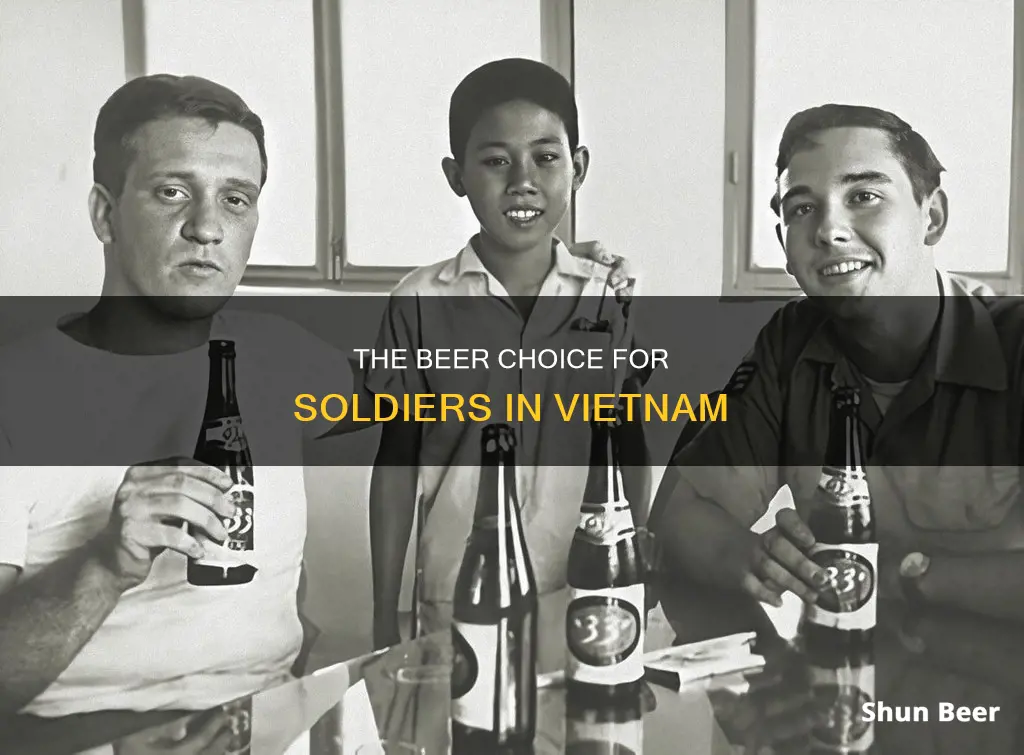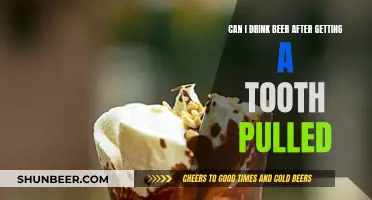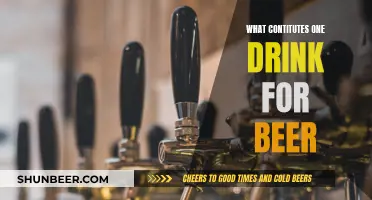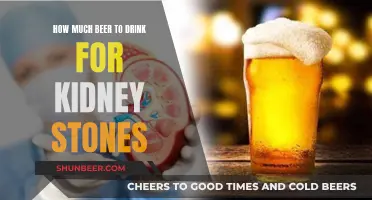
During the Vietnam War, beer was a common drink for soldiers, with an estimated 32 million cans of beer consumed by the 500,000 US forces in Vietnam each month. Pabst Blue Ribbon, Carling Black Label, Budweiser, and Schlitz were among the American beer brands available, while local Vietnamese beers, such as Ba Moui Ba (Biere 33) and Tiger Beer (Biere Larue), were also consumed. The availability of beer provided a sense of comfort and familiarity for the soldiers, despite the challenging conditions they faced in the war.
| Characteristics | Values |
|---|---|
| American beer brands available | Pabst Blue Ribbon, Carling Black Label, Budweiser, Ballantine’s, PBR, Shlitz, Miller, Coors |
| Local Vietnamese beer brands available | Ba Moui Ba (Biere “33”), Tiger Beer (Biere Larue) |
| Beer cans | Old style (pre-“pop top”) cans that required a can-opener (“church key”) |
What You'll Learn
- American beer brands in Vietnam included Pabst Blue Ribbon, Carling Black Label, and Budweiser
- Local Vietnamese beer Ba Moui Ba was also known as Biere 33
- Another local beer, Biere Larue, was called Tiger Beer by soldiers
- Beer was distributed differently depending on the unit. Some drank daily, others saved it for designated days
- Beer cans had flat tops and required a church key to open

American beer brands in Vietnam included Pabst Blue Ribbon, Carling Black Label, and Budweiser
During the Vietnam War, American beer brands that made their way to the troops included Pabst Blue Ribbon, Carling Black Label, and Budweiser. Pabst Blue Ribbon (PBR) and Carling Black Label were often enjoyed by soldiers returning from patrol as they cleaned their weapons. Pabst Blue Ribbon, also known as PBR, was also a favourite of ageing Vietnam veterans once they returned home.
The presence of these American beer brands in Vietnam was made possible by the advent of canned beer. The can offered several advantages over glass bottles, including blocking out light (which can cause beer to spoil), being more durable and portable, and being easier to stack and store. The ability to ship canned beer allowed soldiers to enjoy a taste of home even in the remote jungles of Vietnam.
The beer cans provided to the troops in Vietnam still had flat tops and required a "church key" can opener, even though "pop-top" cans had already become widespread in the US. This was likely due to transportation challenges in shipping the newer "pop-top" cans across the Pacific.
The availability of American beer brands like Pabst Blue Ribbon, Carling Black Label, and Budweiser contributed to the unique experience of the Vietnam War, where beer and combat went hand in hand.
Beer, Mucus, and Coughing: Is There a Link?
You may want to see also

Local Vietnamese beer Ba Moui Ba was also known as Biere 33
During the Vietnam War, beer was a common drink for soldiers, and major logistics hubs provided recreational outlets for troops, including bars and retail stores where they could buy beer. American beer brands like Pabst Blue Ribbon, Carling Black Label, and Budweiser were available in-country. However, when American beers were unavailable, soldiers would drink local Vietnamese beers like "Ba Moui Ba" (also known as Biere "33") and "Tiger Beer" (Biere Larue). These local beers were said to be inconsistent in quality, but the soldiers still consumed them despite rumours that they contained formaldehyde.
Biere "33" (Ba Moui Ba), an iconic local brand, came in bottles that were about the size of a US 12 oz. and tasted okay most of the time. The name "Ba Moui Ba" translates to "33" in English, and the beer is now owned by a subsidiary of Foster's Group of Australia and may be available as Biere "33" Export in the US. Interestingly, it has been reported that the name was changed to "333" or "ba-ba-ba" by the Russians when they moved into Vietnam after 1975.
The availability of beer, both American and local, provided a sense of continuity for soldiers serving in Vietnam, and even today, Vietnam veterans can find comfort in purchasing the same beer brands they drank during their youth in a distant land.
Beer and Clonazepam: Safe Mix or Risky Business?
You may want to see also

Another local beer, Biere Larue, was called Tiger Beer by soldiers
During the Vietnam War, beer was a common drink for soldiers, with some sources stating that beer and combat went hand in hand. While American beer brands like Pabst Blue Ribbon, Carling Black Label, and Budweiser were available, soldiers also had access to local Vietnamese beers. One such beer was "Ba Moui Ba" or "33", which was said to have an okay taste. Another local beer, Biere Larue, was called "Tiger Beer" by soldiers.
Biere Larue, or "Tiger Beer", usually came in one-liter bottles and was known for its inconsistent quality. Some bottles tasted bitter, while others had hints of formaldehyde or vinegar. However, occasionally, one might come across a bottle that tasted quite good. Despite the mixed reviews, "Tiger Beer" offered a break from the hardships of war and provided some familiarity and comfort to the soldiers.
The availability of beer during the Vietnam War was not limited to the local Vietnamese options. American beer companies donated rations for troops, ensuring they could enjoy a cold one after a long day. The PX, or military Post Exchange, also played a significant role in providing beer and other consumer goods to the soldiers. The PX at Long Binh, located 20 miles north of Saigon, generated approximately $800,000 in monthly sales from beer alone.
The humid climate of Vietnam made cold beer particularly appealing to the troops. To enjoy a chilled drink, soldiers had to get creative. They would often use clay water crocks or tubs sourced from the local economy and barter with locals for ice to create makeshift coolers. These improvised coolers ensured that, even in the most remote locations, soldiers could look forward to a cold beer at the end of their patrols.
The presence of beer during the Vietnam War extended beyond the beverage itself. It represented a connection to home, a brief escape from the realities of war, and a means to unwind and bond with fellow soldiers. Whether it was a taste of home in a can of American beer or an adventure in a bottle of local "Tiger Beer", beer played a notable role in the lives of soldiers during the Vietnam War.
Beer and Gluten Intolerance: Is There a Link?
You may want to see also

Beer was distributed differently depending on the unit. Some drank daily, others saved it for designated days
Beer was a popular drink for soldiers during the Vietnam War. The hot and humid climate of Vietnam made cold beer appealing to troops, and the lack of clear front lines meant that recreational drinking was more feasible than in contemporary conflicts. Beer was often shipped to even the most remote firebases, and some units even augmented their rations by pooling funds to buy more beer during resupply missions.
Every unit had a different method for distributing beer. Some units would drink beer daily, returning from patrol and enjoying a beer as they cleaned their weapons. Other units kept their beer locked up until a designated day when they could relax and drink together.
American beer brands like Pabst Blue Ribbon, Carling Black Label, Budweiser, Schlitz, and Miller were available in Vietnam. Pabst Blue Ribbon, or PBR, was particularly popular, and one estimate puts the total beer sales in Vietnam at just under $4 million a month. With a can of beer costing around 15 cents, the 500,000 US forces in Vietnam likely consumed around 32 million cans of beer per month.
When the usual American beers were unavailable, soldiers would drink local Vietnamese beers like "Ba mui ba" or "33", and "Tiger Beer" (also known as Biere Larue). These beers were less consistent in quality, but still enjoyed by the troops.
Beer and Lithium: What's the Verdict?
You may want to see also

Beer cans had flat tops and required a church key to open
During the Vietnam War, beer cans had flat tops and required a "church key" to open. This was a small piece of steel that was used to puncture a hole in the top of the can for venting and a second, larger hole for pouring. While "pop-top" cans, which featured the "`pull-tabs` common today", were already in widespread use in the United States, the flat-top design without pull-tabs continued to be shipped to troops in Vietnam.
The flat-top design of beer cans during the Vietnam War was a carryover from the early days of canned beer. The challenges of canning beer due to carbonation and metal interaction with the beverage meant that early attempts at canned beer were met with limited success. However, the American Can Company's development of Vinylite, an internal coating that prevented beer-metal interaction, paved the way for the first beer can in 1935.
Despite the evolution of can design in the United States during the 1960s, with the introduction of "pop-top" features, military personnel in Vietnam still received cans with flat tops. This was likely due to the challenges of transporting the newer "pop-top" cans over long distances by ship. The flat-top design, while requiring the use of a church key, offered advantages in terms of light blocking, durability, stacking, and storage efficiency.
The act of opening a beer can with a church key became a familiar ritual for soldiers in Vietnam. It provided a sense of continuity and a taste of home, even in the midst of the hardships and dangers of war. Returning to their base after a long day, soldiers would use their church keys to open cans of chilled beer, often kept in improvised coolers, and relax while cleaning their equipment and preparing for the next day.
The flat-top beer cans and church keys of the Vietnam War era stand as a reminder of the resilience and adaptability of both the troops and the beverage industry. While technology has advanced and drinking regulations have changed, the connection between a cold beer and a sense of comfort for military personnel remains.
Beer and Bone Biopsy: Is It Safe to Drink?
You may want to see also
Frequently asked questions
Soldiers in Vietnam drank a variety of beers, including American brands like Pabst Blue Ribbon, Carling Black Label, Budweiser, Schlitz, and Ballantine’s. They also drank local Vietnamese beers like "Ba Moui Ba" (Biere "33") and Tiger Beer (Biere Larue).
Yes, the cans of beer provided to soldiers in Vietnam were the old-style pre-"pop top" cans that required a can opener ("church key"), even though "pop tops" had already been in widespread use in the US for several years.
Yes, there were rumors that the local Vietnamese beer, "Ba Moui Ba" ("33"), contained formaldehyde. However, this did not seem to deter consumption.







